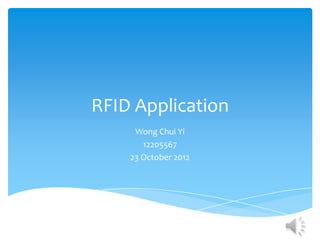
12205567‐pss7
- 1. RFID Application Wong Chui Yi 12205567 23 October 2012
- 2. Workflow Future Survey development Introduction Applications conclusion results and opportunity
- 3. RFID RFID = Radio Frequency Identification Electronic labeling and wireless identification of objects using radio frequency Tag carries with its information a serial number Model number Color or any other imaginable data When these tags pass through a field generated by a compatible reader, they transmit this information back to the reader, thereby identifying the object
- 4. RFID components A basic RFID system consists of these components: A programmable RFID tag/inlay for storing item data; Consisting of an RFID chip for data storage an antenna to facilitate communication with the RFID chip A reader/antenna system to interrogate the RFID inlay Application software and a host computer system
- 5. RFID Tag The RFID tag consists of an integrated circuit (IC) embedded in a thin film medium. Information stored in the memory of the RFID chip is transmitted by the antenna circuit embedded in the RFID inlay via radio frequencies, to an RFID reader 3 types Passive Semi-passive Active
- 6. Types of RFID Tags Active Tags Semi-passive Tags Passive Tags •Use a battery •Contain built-in •Derive their power •communicate over batteries to power the from the field distances of several chip’s circuitry, resist generated by the meters interference and reader circumvent a lack of •without having an power from the reader active transmitter to signal due to long transfer the distance. information stored •They are different from active tags in that they only transmit data at the time a response is received
- 7. Applications Frequency Appx. Read Range Data Speed Cost of Application Tags Low Frequency (125kHz) <5cm Low High • Animal Identification (passive) • Access Control High Frequency (13.56 10 cm – 1m Low to Moderate Medium • Smart Cards Mhz) to Low (passive) • Payment (paywave) Ultra High Frequency 3m -7m Moderate to High Low • Logistics and Supply Chain (433, 868-928 Mhz) (passive) • Baggage Tracking Microwave (2.45 & 5.8 10m -15m High High • Electronic toll collection (Autotoll) Ghz) (passive) • Container Tracking 20m – 40m (active)
- 8. Current Applications Application Segment Representative Competitive Technologies Current Typical Tag Type Applications Penetration Access Control Doorway entry Other keyless entry High Passive technologies Asset Tracking Locating tractors within a None Low Active freight yard Asset Tagging Tracking corporate Bar Code Low Passive computing systems Authentication Luxury goods counterfeit Holograms Low Passive prevention Baggage Tracking Positive bag matching Bar Code, Optical Character Low Passive Recognition POS Applications SpeedPass Credit Cards, Smart Cards, Medium Passive Wireless Phones SCM (Container Level) Tracking containers in GPS-based Systems Low Active shipping terminals SCM (Pallet Level) Tracking palletized Bar Code Minimal Active, Passive shipments SCM (Item Level) Identifying individual Bar Code Minimal Passive items Vehicle Identification Electronic toll collection Bar Code, License plate, Medium Active, Passive reader systems Vehicle Immobilizers Automotive ignition Other theft prevention High Passive systems technologies
- 9. Credit Cards with RFID (Paywave function) Applications Octopus (Smart Card)
- 10. Applications Autotoll (Electronic toll collection) Access Control
- 11. Online Survey Target: SME Information: Opinion on RFID and its applications Site: http://qtrial.qualtrics.com/SE/?SID=SV_9N5UPRZuyuWts k4
- 12. Survey Result
- 13. Further Development In medical uses and library management
- 14. Video
- 15. Conclusion Positive RFID is a contactless reading technology and can read through other materials Hold more data than barcode does RFID tags data can be changed or added More effective, bring lots of convenience to us Negative Cost is relatively remain high (compare to barcode) RFID signals may have problems with some materials RFID standards are still being developed